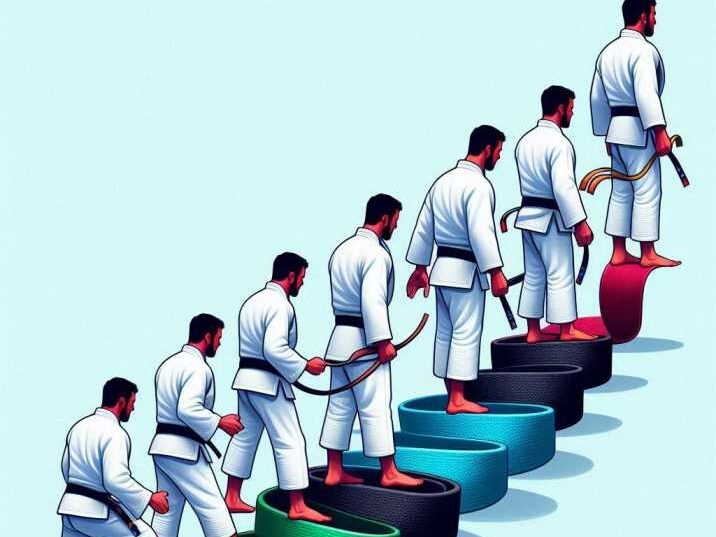Introduction
Table of Contents
Imagine stepping onto the tatami (mat) for the first time, your heart pounding with excitement and a hint of nervousness. You’re surrounded by practitioners of all ages, each donning belts of different colors around their waists. What do these colors signify? How do they represent the journey of a judoka (a judo practitioner)? Welcome to the fascinating world of judo belt colors. In this comprehensive guide, we’ll explore the history, significance, and progression of judo belts, providing a detailed roadmap for every judoka’s journey. Whether you’re a beginner or an experienced practitioner, this post will shed light on the meaning behind each belt and what it takes to advance in the art of judo.

The Historical Significance of Judo Belt Colors
The Origins of the Belt System
The belt system in judo, known as the “kyu-dan” ranking system, was introduced by Jigoro Kano, the founder of judo, in the late 19th century. Kano’s vision was to create a structured way to measure a student’s progress and skill level. Before this system, martial arts rankings were less formalized, often based on the subjective judgment of a master. Kano’s system revolutionized martial arts by providing clear, achievable goals for practitioners.
The Symbolism of Colors
Each judo belt color symbolizes a different stage of learning and personal growth. The colors are not arbitrary; they represent the natural progression of a judoka’s journey from novice to master. Here’s a brief overview of the symbolism behind the colors:
- White: Purity and innocence. A blank slate, open to learning.
- Yellow: The first rays of sunlight, representing new knowledge.
- Orange: The strength of the rising sun, indicating growing skills.
- Green: Growth and development, like plants reaching for the sun.
- Blue: The vastness of the sky, symbolizing expanded horizons.
- Brown: Maturity and solid grounding in the art.
- Black: Mastery, depth of knowledge, and the beginning of true understanding.
The Progression Through Judo Belt Colors
Beginner Belts (Kyu Grades)
White Belt (6th Kyu)
The white judo belt is where every judoka’s journey begins. As a white belt, the student is introduced to the fundamental principles of judo, including basic techniques (waza), breakfalls (ukemi), and the philosophy of judo. The focus at this stage is on building a strong foundation and understanding the core concepts.Key Learning Points:
- Basic throws (nage-waza) like O-goshi (hip throw) and Ippon seoi nage (one-arm shoulder throw).
- Basic ground techniques (ne-waza) such as pins (osaekomi-waza).
- Fundamental judo etiquette and dojo manners.
Yellow Belt (5th Kyu)
Earning the yellow belt signifies the judoka’s first step towards advancement. The student has demonstrated a grasp of basic techniques and is now ready to build upon this foundation.Key Learning Points:
- Intermediate throws like Osoto gari (large outer reap) and Koshi guruma (hip wheel).
- Introduction to combination techniques (renraku-waza) and counters (kaeshi-waza).
- Improved ukemi skills to ensure safe practice.
Orange Belt (4th Kyu)
The orange belt reflects further development in the judoka’s skills and understanding. At this level, students start to refine their techniques and begin to understand the strategic aspects of judo.Key Learning Points:
- More advanced throws such as Harai goshi (sweeping hip throw) and Tomoe nage (circular throw).
- Introduction to joint locks (kansetsu-waza) and strangles (shime-waza).
- Enhanced ne-waza techniques and transitions.
Intermediate Belts
Green Belt (3rd Kyu)
The green belt signifies a significant milestone in a judoka’s journey. At this stage, the student’s techniques become more fluid and effective, and they begin to understand the intricate timing and balance required in judo.Key Learning Points:
- Advanced throws like Uchi mata (inner thigh throw) and Sode tsurikomi goshi (sleeve lifting pulling hip throw).
- More complex combination techniques and counters.
- Greater emphasis on randori (free practice) to apply techniques in a dynamic setting.
Blue Belt (2nd Kyu)
The blue belt represents a deepening of knowledge and technical proficiency. Judokas at this level are expected to demonstrate greater control and precision in their techniques.Key Learning Points:
- Mastery of advanced throws and their variations.
- Improved strategic thinking and application of techniques in randori.
- In-depth study of ne-waza, focusing on transitions and submissions.
Brown Belt (1st Kyu)
The brown belt is the final kyu grade before a judoka can achieve a black belt. At this level, students are proficient in all basic and many advanced techniques. The focus is on polishing skills and preparing for the dan (black belt) ranks.Key Learning Points:
- Mastery of all previous techniques and their application in competitive scenarios.
- Advanced randori, demonstrating fluidity, control, and strategic acumen.
- Preparation for the black belt test, including kata (formalized patterns of movements).
Advanced Belts (Dan Grades)
Black Belt (1st Dan and Above)
Attaining a black belt is a significant achievement, marking the transition from student to master. However, in judo, a black belt is often seen as the beginning of a deeper journey into the art. There are multiple degrees (dans) of black belt, each representing a higher level of expertise and contribution to the martial art.Key Learning Points:
- Continued refinement and mastery of techniques.
- In-depth study of judo philosophy and teaching methods.
- Contribution to the judo community through teaching, mentoring, and promoting the art.
The Importance of Each Belt Color
Encouraging Progress and Motivation
The belt system in judo is designed to motivate students by providing clear, attainable goals. Each belt color represents a milestone in the judoka’s journey, offering a sense of achievement and encouraging continued growth.
Building a Strong Foundation
Each stage in the belt progression builds upon the previous one, ensuring that students develop a strong foundation before moving on to more advanced techniques. This structured approach helps prevent injuries and ensures a thorough understanding of judo principles.
Fostering Respect and Discipline
The belt system also fosters a sense of respect and discipline. Judokas learn to respect their instructors and fellow practitioners, understanding that each belt color represents a different level of experience and knowledge. This respect is a core tenet of judo philosophy.
The Journey of a Judoka: Beyond the Belts
The Role of Competitions and Tournaments
Competitions and tournaments play a crucial role in a judoka’s development. They provide an opportunity to test skills in a real-world setting, learn from opponents, and gain valuable experience. Success in competitions can also influence belt promotions, particularly at higher levels.
The Lifelong Path of Learning
Judo is often described as a lifelong journey. Even after achieving a black belt, practitioners continue to learn and grow. The higher dan grades represent not just technical proficiency but also a deeper understanding of judo philosophy and a commitment to teaching and spreading the art.
The Community and Camaraderie
One of the most rewarding aspects of judo is the sense of community. Training alongside others, sharing experiences, and supporting each other’s growth creates strong bonds and lifelong friendships. The dojo becomes a second home, and the people in it become an extended family.

Table of Information about Judo Belt
| Belt Color | Kyu/Dan Rank | Symbolism | Key Techniques | Focus Areas |
|---|---|---|---|---|
| White | 6th Kyu | Purity and innocence, readiness to learn | Basic throws, breakfalls | Fundamentals, core concepts |
| Yellow | 5th Kyu | First rays of sunlight, new knowledge | Intermediate throws | Combination techniques, improved ukemi |
| Orange | 4th Kyu | Rising sun, growing skills | Advanced throws | Joint locks, strangles, enhanced ne-waza |
| Green | 3rd Kyu | Growth and development | Uchi mata, Sode tsurikomi goshi | Strategic application, advanced randori |
| Blue | 2nd Kyu | Vast horizons, expanded knowledge | Mastery of advanced throws | Higher-level randori, complex techniques |
| Brown | 1st Kyu | Maturity and solid grounding | Mastery of all techniques | Competitive scenarios, kata preparation |
| Black | 1st Dan+ | Mastery, depth of understanding | Continued refinement | Teaching, mentoring, contributing to the judo community |
Conclusion
The journey through judo belt colors is a transformative experience that goes beyond physical techniques. It encompasses personal growth, discipline, respect, and a deeper understanding of oneself and others. Each belt color represents a step on this journey, marking progress and encouraging continued learning. Whether you’re just starting out as a white belt or striving for higher dan ranks, remember that judo is not just about the destination but the journey itself. Embrace each stage, learn from every experience, and enjoy the path you’re on as a judoka.
By understanding the significance of judo belt colors, you’ll gain a greater appreciation for the art of judo and the dedication it requires. So, tie your belt with pride and step onto the tatami with confidence, knowing that you’re part of a rich tradition that has inspired countless practitioners around the world.
FAQs
1. What is the significance of judo belt colors?
Judo belt colors represent the progression and skill level of a judoka. Each color signifies a different stage of learning, from beginner (white) to advanced (black), and reflects the judoka’s growth and development in the art.
2. How long does it typically take to earn a black belt in judo?
The time it takes to earn a black belt in judo varies depending on the individual’s dedication, frequency of training, and ability to master techniques. On average, it can take anywhere from 5 to 10 years of consistent practice.
3. What is the highest rank in judo?
The highest rank in judo is the 10th dan, which is extremely rare and represents an exceptional level of mastery and contribution to the art. Most practitioners will aim for ranks up to the 6th or 7th dan in their lifetime.
4. Are there specific requirements for belt promotions in judo?
Yes, belt promotions in judo are based on a combination of factors including technical proficiency, knowledge of techniques, competition performance, and time spent training. Each dojo may have specific requirements and tests for promotions.
5. Can children and adults progress through judo belts at the same rate?
Children and adults progress through judo belts at different rates due to differences in physical development, learning pace, and available training time. Children often have separate belt systems with additional colors to accommodate their growth and development.


